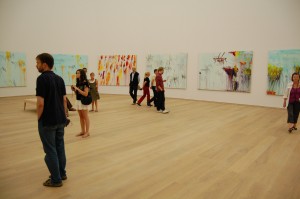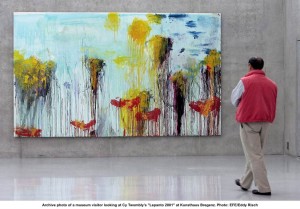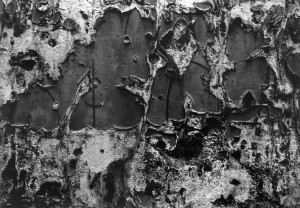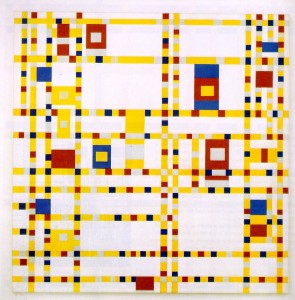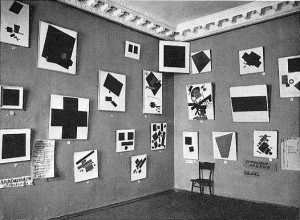 The 2004 Turner prize-winning artist Jeremy Deller uses this quotation from Shakespeare (“What is the city but the people?”) as the title for his current project on the London underground. Tube drivers are given a booklet with quotations from philosophers, writers, and other intellectuals, to read on the Piccadilly line, adding a personal touch to an otherwise routine commute. Amidst the usual announcements like “Mind the gap,” commuters are treated to memorable sayings like Engels’s, “An ounce of action is worth a ton of theory,” or Dostoevsky’s, “Beauty will save the world.” Following are several other examples:
The 2004 Turner prize-winning artist Jeremy Deller uses this quotation from Shakespeare (“What is the city but the people?”) as the title for his current project on the London underground. Tube drivers are given a booklet with quotations from philosophers, writers, and other intellectuals, to read on the Piccadilly line, adding a personal touch to an otherwise routine commute. Amidst the usual announcements like “Mind the gap,” commuters are treated to memorable sayings like Engels’s, “An ounce of action is worth a ton of theory,” or Dostoevsky’s, “Beauty will save the world.” Following are several other examples:
“There is more to life than increasing at speed.” Mahatma Gandhi
“Hell is other people” Jean-Paul Sartre
“Everyone should be respected, but no-one idolised” Albert Einstein
“Nothing is worth more than this day” Johann von Goethe”
“The only reason for time is so that everything doesn’t happen at once” Albert Einstein
“The afternoon knows what the morning never expected” William Shakespeare
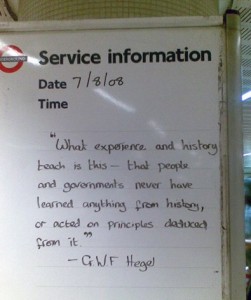
Deller says of this project, “Originally, when asked to think about a project for London Underground (LU), I suggested a day of no announcements on the Underground, but obviously this was not possible, so I came up with the idea to give staff a collection of quotes and the idea grew from there. I often wish announcements were more personal and reflected the realities and absurdities of living and working in a big city. I think the traveling public enjoys some humour and unexpected insight during their journey.”

In another current public art project in London, the sculptor Antony Gormley has asked for ordinary people to occupy the empty fourth plinth in Trafalgar Square to demonstrate, well, “What is the city but the people?” The work is titled One and Other. You can watch a live feed of the “plinthers,” as the participants are called, reading poems, talking to the public, sleeping, etc. as they occupy the fourth plinth. Every hour for 100 days, a new person will assume the position; the idea is to portray the whole of humanity, not merely kings and generals, in this living sculpture project.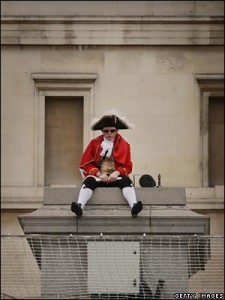
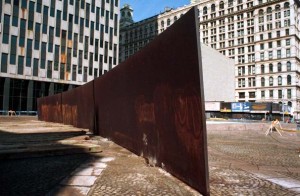 Last week in class we discussed the controversy surrounding Richard Serra’s Tilted Arc . In 1981, the sculpture was installed in Federal Plaza in New York. It was commissioned by the U.S. General Services Commission, which earmarks .5% of a federal buildings cost for art work; Serra’s curving wall of raw steel cost $175,000. It was disliked by many of the people who used the park, and the public complaints resulted in a hearing, and the eventual removal of the sculpture. “I don’t think it is the function of art to be pleasing,” Serra comments at the time. “Art is not democratic. It is not for the people.”
Last week in class we discussed the controversy surrounding Richard Serra’s Tilted Arc . In 1981, the sculpture was installed in Federal Plaza in New York. It was commissioned by the U.S. General Services Commission, which earmarks .5% of a federal buildings cost for art work; Serra’s curving wall of raw steel cost $175,000. It was disliked by many of the people who used the park, and the public complaints resulted in a hearing, and the eventual removal of the sculpture. “I don’t think it is the function of art to be pleasing,” Serra comments at the time. “Art is not democratic. It is not for the people.”
Hmm. What is the city but the people? Nathan Glazer in his book From a Cause to a Style points out that Serra’s Tilted Arc, a piece that was intended to be anti-capitalist and favor the working class, “ends in the furthest reaches of elitism, rejected by those for whom it was originally designed….” Opponents of Tilted Arc were not so much concerned with the artist’s intention as they were with enjoying the sun in the plaza and having a pleasant outdoor spot to eat their lunch without a being “assaulted by a very large and ugly object whose purposes they could not divine” (Glazer’s words, not mine). It is incorrect to assume the complaints about this sculpture came from philistines who didn’t appreciate the significance of public art works; No less than Carole Glueck of thre New York Times wrote that it is an “awkward, bullying piece that may conceivably be the ugliest outdoor work of art in the city.”
In defense of his work, Serra stated, “it is the explicit intention of site-specific works to alter their context…. Works which are built within the contextual frame of governmental, corporate, educational, and religious institutions run the risk of being read as tokens of these institutions…. In such cases, it is necessary to work in opposition to the constraints of the context, so that the work cannot be read as an affirmation of questionable ideologies of political power. I am not interested in art as affirmation and complicity.”

I doubt the people who protested the arc disagreed with this social critique. The question is – to paraphrase Glazer – do you combat the awfulness of these institutions and ideologies by adding to the awfulness with a visually unappealing work?
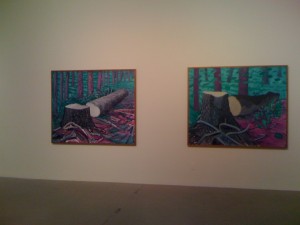 The exuberant colors and tactile surface of the paintings are so refreshing, especially after seeing the usual gallery offerings: badly painted images of sex organs (see Mike Kelley at Gagosian), inscrutable installation art (see Mark Manders at Tanya Bonakdar), and elaborate conceits using found objects (see Fischli and Weiss at Matthew Marks). I still adore Fischli and Weiss, but a life story told with 800 magazine ads…. I guess I disliked it precisely because I do enjoy their photographs and wished to see some. As for their sculptures, I preferred the Sleeping Puppets to the everyday objects in Clay and Rubber.
The exuberant colors and tactile surface of the paintings are so refreshing, especially after seeing the usual gallery offerings: badly painted images of sex organs (see Mike Kelley at Gagosian), inscrutable installation art (see Mark Manders at Tanya Bonakdar), and elaborate conceits using found objects (see Fischli and Weiss at Matthew Marks). I still adore Fischli and Weiss, but a life story told with 800 magazine ads…. I guess I disliked it precisely because I do enjoy their photographs and wished to see some. As for their sculptures, I preferred the Sleeping Puppets to the everyday objects in Clay and Rubber.  Another highlight was Eric Fischl at Mary Boone. His striking compositions of matadors are painted with his characteristically loose broad brushwork. In the wide spectrum of artistic attitudes between sincerity and irony, I think Fischl is closer to the former. Perhaps he is referencing Manet; I viewed the Manet matador paintings at the Frick almost immediately after seeing the Fischl show. To my eye, there are similarities in their works which go beyond subject. I’m still a little unsure what to make of it, but I’m fairly certain it is not an attempt at kitsch….
Another highlight was Eric Fischl at Mary Boone. His striking compositions of matadors are painted with his characteristically loose broad brushwork. In the wide spectrum of artistic attitudes between sincerity and irony, I think Fischl is closer to the former. Perhaps he is referencing Manet; I viewed the Manet matador paintings at the Frick almost immediately after seeing the Fischl show. To my eye, there are similarities in their works which go beyond subject. I’m still a little unsure what to make of it, but I’m fairly certain it is not an attempt at kitsch…. In his 1999 wax sculpture, Ninth Hour, Maurizio Cattelan portrays Pope John Paul II struck by a meteorite. Typically, contemporary artists have had little dialogue with the Vatican, or have portrayed the Vatican hierarchy in an unfavorable way. From the look of things at this recent event, artists would gladly accept commissions from the Vatican, but as Archbishop Ravasi reminds us, “I wouldn’t rule it [commissions] out, but we’re not in the Renaissance.”
In his 1999 wax sculpture, Ninth Hour, Maurizio Cattelan portrays Pope John Paul II struck by a meteorite. Typically, contemporary artists have had little dialogue with the Vatican, or have portrayed the Vatican hierarchy in an unfavorable way. From the look of things at this recent event, artists would gladly accept commissions from the Vatican, but as Archbishop Ravasi reminds us, “I wouldn’t rule it [commissions] out, but we’re not in the Renaissance.”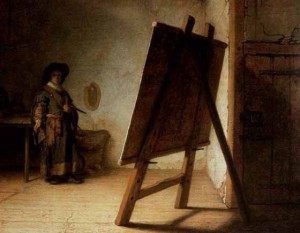

 Andy Warhol once said he liked “boring things” and wanted things to be “exactly the same over and over again.”
Andy Warhol once said he liked “boring things” and wanted things to be “exactly the same over and over again.” Many artists followed his lead, including Jeff Koons and Claes Oldenburg whom we discussed in class. We’ll look at many other examples in the remaining weeks of the semester…. Rest assured, there’s lots of boring work to come.
Many artists followed his lead, including Jeff Koons and Claes Oldenburg whom we discussed in class. We’ll look at many other examples in the remaining weeks of the semester…. Rest assured, there’s lots of boring work to come.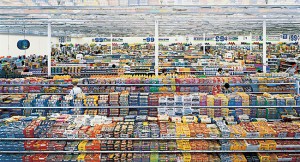
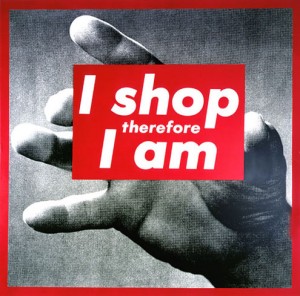
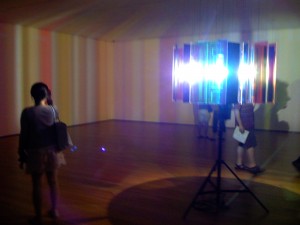

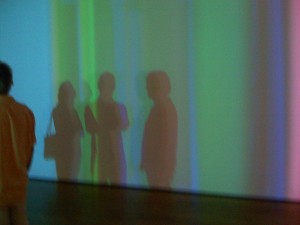


 The 2004 Turner prize-winning artist
The 2004 Turner prize-winning artist 


 Last week in class we discussed the controversy surrounding
Last week in class we discussed the controversy surrounding 
